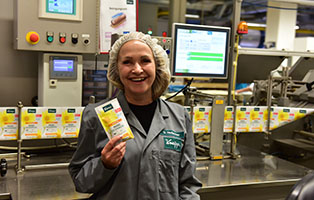
Kneipp improves their packaging process with in-line seal inspection
Today we visit the Kneipp® Oberhauser plant near Würzburg with Mrs. Heilscher, responsible for lean manufacturing. In this modern production plant, a wide variety of products are processed, including bath, body care, and even nutritional supplies.
DOWNLOAD PDF
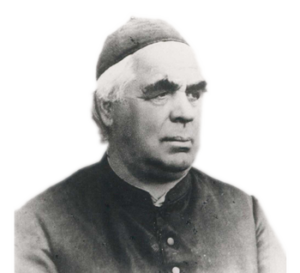
For Sebastian Kneipp, water was everything. He was known as the “Water Doctor” in Europe, pioneering hydrotherapy 130 years ago. People came from afar seeking his healing expertise and that tradition continues today. Only now, with the naturally pure bathing salts, one can experience it in the soothing comfort of its own bathtub. The perfumed crystals packaged in easy-to-use sachets require perfect sealing to prevent leaking crystals, aromatic loss and cosmetic seal deficiencies.
Unique deep salt
The primary ingredient of the Kneipp bath salts are natural salt crystals, whereby for certain product series the renowned Luisenhall deep salt is used. This originates from the Luisenhall salt works and is extracted at a depth of 460 meters from the brine of a 250-million-year-old primeval sea. While the crystals of evaporated salt have a rough, but closed surface, deep salt has a kind of crater landscape. With the help of these tiny cave systems, the salt crystals can literally absorb essential oils. In water, the bath salt dissolves and releases the active ingredients. Unlike many other salts, the primal salt in the depths of the Luisenhaller earth is protected from environmental pollution – and therefore free from harmful residues from fine dust and exhaust fumes.
Packaging in sachets
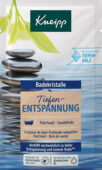 The precious salt crystals are packaged in sachets on different packaging lines including a rotary pouch/sachet packaging line and a horizontal-form-fill-seal (HFFS) machine. As Kneipp is associated with outstanding quality products, there is a definite need for in-line seal inspection of the sachets to guarantee the outgoing product quality. As salt is a brittle product, it will contaminate the seal if it gets crushed between the sealing bars during filling and sealing phase. With the high production volumes of up to 60.000 packages per day, it is nearly impossible to manually inspect every single sachet. This is why Kneipp was looking for an automatic, in-line seal detection solution.
The precious salt crystals are packaged in sachets on different packaging lines including a rotary pouch/sachet packaging line and a horizontal-form-fill-seal (HFFS) machine. As Kneipp is associated with outstanding quality products, there is a definite need for in-line seal inspection of the sachets to guarantee the outgoing product quality. As salt is a brittle product, it will contaminate the seal if it gets crushed between the sealing bars during filling and sealing phase. With the high production volumes of up to 60.000 packages per day, it is nearly impossible to manually inspect every single sachet. This is why Kneipp was looking for an automatic, in-line seal detection solution.
In-line seal inspection is key to reduce manual QC
Kneipp learned about the automated, in-line SealScope® solution while visiting an international packaging tradeshow. The in-line seal inspection system instantly caught my attention.“, comments Frau Heilscher, “This could definitely address our inspection needs for the bath salt packaging lines.”
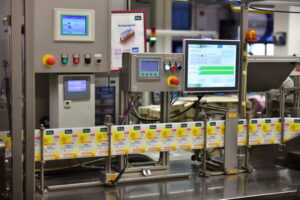 The innovative SealScope® system uses sensors mounted on the sealing bars to detect undesired product in the seal or folds, which can lead to open packages. Every produced package is instantly compared to a reference seal and when sealing errors are detected, the defective packages are automatically ejected from the conveyor belt. As bathing salt is a precious product, the rejected products are reworked, so there is no production waste.
The innovative SealScope® system uses sensors mounted on the sealing bars to detect undesired product in the seal or folds, which can lead to open packages. Every produced package is instantly compared to a reference seal and when sealing errors are detected, the defective packages are automatically ejected from the conveyor belt. As bathing salt is a precious product, the rejected products are reworked, so there is no production waste.
At first, the rotary packaging line was equipped with SealScope® to verify seal defects such as salt that is stuck in the seal. Even when the seal itself is not breached, product in seal is not acceptable for esthetic reasons. SealScope® also detects folds or plies in the sealing area which can also lead to leaking packages. This is equally important to avoid the salt losing its aromatic qualities or spill in the final carton end-packaging box.
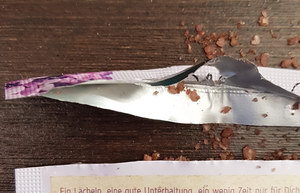 “Before using SealScope we had to manually eliminate bad sachets from our production, which was an inefficient process.”, comments Herr Klaus Müller, Technical Director Kneipp, “By using our automated seal inspection, we are able to eliminate nearly all defective packages in the production output.”
“Before using SealScope we had to manually eliminate bad sachets from our production, which was an inefficient process.”, comments Herr Klaus Müller, Technical Director Kneipp, “By using our automated seal inspection, we are able to eliminate nearly all defective packages in the production output.”
With the high amount of product variations and package sizes, SealScope® is also highly suited to keep all the production data stored per product type. A change in product requires about half an hour to replace the foil and clean the product fillers. SealScope® records all data per new production batch, so that eventual errors can be traced back to the exact product data.
Monitoring function supports lean manufacturing
But there is more. Another interesting function of SealScope® is the monitoring of the packaging process. Because each package is measured, it is also possible to register trends and deficiencies in the production process. In this way, if the rejection ratio increases, the packaging process can automatically be paused after e.g. ten defective packages and maintenance can be done. Or the machine can be timely adjusted, which can prevent production of bad packages and production delays. Typical issues can occur with small foil parts or salt that are built on the heated sealing bars.
From environmental perspectives, this is also beneficial to reduce plastic film waste as the production is instantly stopped when there are occurring consecutive sealing issues.
Also highly valued is the remote support via TeamViewer. In the rare case there is a technical question or issue with the seal inspection system, the Kneipp team can consult with the support team in Belgium, who can directly access the installation to provide assistance. This avoids enduring and expensive support visits.
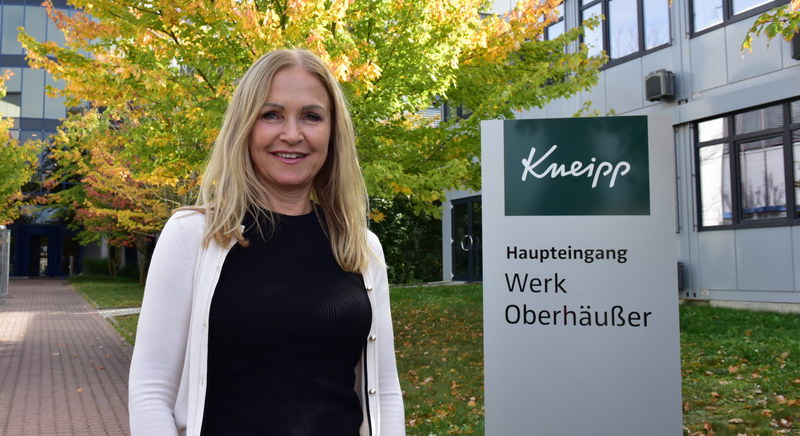
“We learned about the automated, in-line SealScope® solution on a tradeshow. The in-line seal inspection system instantly caught my attention, as it could definitely address our seal inspection needs for the bath salt packaging lines.” – Frau Heilscher – Lean Manufacturing
Further deployment of seal inspection automation
As Kneipp is gradually automating the production and packaging, in-line seal inspection will continue to play an important role in further upgrades of packaging lines. “We are definitely pleased with the automated seal inspection solution.”, concludes Herr Müller, “The implementation of SealScope® is resulting in automated quality control, better process management and cost reduction on manual labor.” Also, our quality requirements are very challenging, as we need to comply as well to pharmaceutical, cosmetics and food standards. In this sense, the in-line seal inspection fits perfectly in the quality philosophy of Kneipp.
Another interesting project is being investigated for inspecting the end seals of tubes for e.g. shower and shampoo gels. Kneipp and the research team of Engilico are evaluating the use of hyperspectral imaging, with the purpose of detecting leaks in the opaque seals of the tubes. As such, Engilico’s seal inspection can be a solution to the challenges of today and tomorrow.
DOWNLOAD PDF